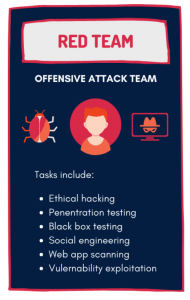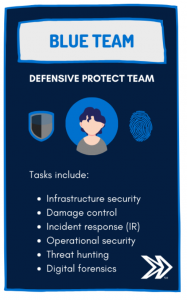Week 1: One Team, Two Team, Red Team, Blue Team
Maleea m -
Brute force, backdoors, sneaky attacks,
Red Team is hunting for critical cracks.
Blue Team defends, firewalls tight,
Mending and tending to end the fight

In my previous post, I introduced you to the concept of “ethical hacking”—two words that might seem like complete opposites. Ethical hacking is the authorized use of hacking techniques to identify security vulnerabilities in a system.
Think of cybersecurity as a constant war between attackers and defenders. Just like in traditional battles, both sides must train, strategize, and adapt. In this digital battlefield, we have two key players:
- Red Team – The attackers (but the good kind)
- Blue Team – The defenders (keeping systems secure)
These teams simulate real-world cyber threats, working against each other to strengthen security.


Most large companies have red and blue teams working every day, the battle is happening all around you all the time. By having Red Teams attack and Blue Teams defend, organizations can find and fix weaknesses before real hackers do. This ongoing battle keeps security strong and helps protect sensitive information from cyber threats.
For my senior project, I’ll be applying Red and Blue Team tactics (Purple Team) by ethically hacking various IoT devices to uncover security gaps and then patching them. This hands-on experience will allow me to explore both sides of cybersecurity—learning how attackers break in and how defenders keep them out.
Project Update:
I’m currently in the reconnaissance stage—the initial phase of a cyber attack where information is gathered about a target system or network before launching an attack. This step is crucial in both offensive and defensive cybersecurity, as understanding potential vulnerabilities is key to securing a system.
Right now, I’m building my knowledge base by:
- Watching YouTube tutorials on network architecture and security fundamentals.
- Completing Cyber Security 101 on TryHackMe to explore attack techniques, defense strategies, and reconnaissance methods.
“Fun” Frightening Fact of The Week:
A cyberattack occurs every 39 seconds leading to 4 million files stolen every day.
Consider my timbers shivered.

Comments:
All viewpoints are welcome but profane, threatening, disrespectful, or harassing comments will not be tolerated and are subject to moderation up to, and including, full deletion.